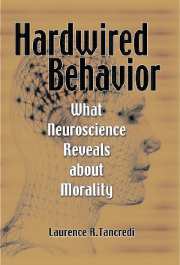Book contents
- Frontmatter
- Contents
- Preface
- Acknowledgments
- 1 Neuroscience and Morality
- 2 Morality and the Mind
- 3 Beyond the Mind Zone
- 4 The Moral Brain
- 5 Bad without Conscience
- 6 The Biology of Choice
- 7 Sex and the Single Moral Code
- 8 Brain Biology and Sex
- 9 Deception
- 10 The Biology of Money
- 11 The Bad and the Mad
- 12 Creating a Moral Brain
- Notes
- Glossary
- Index
11 - The Bad and the Mad
Published online by Cambridge University Press: 13 October 2009
- Frontmatter
- Contents
- Preface
- Acknowledgments
- 1 Neuroscience and Morality
- 2 Morality and the Mind
- 3 Beyond the Mind Zone
- 4 The Moral Brain
- 5 Bad without Conscience
- 6 The Biology of Choice
- 7 Sex and the Single Moral Code
- 8 Brain Biology and Sex
- 9 Deception
- 10 The Biology of Money
- 11 The Bad and the Mad
- 12 Creating a Moral Brain
- Notes
- Glossary
- Index
Summary
Only one letter distinguishes “bad” from “mad,” but these notions have been considered to be at opposite ends of a spectrum of extreme and unacceptable social behaviors. Both of them reveal the power of abnormal human forces that affect personal controls. “Madness,” we feel, means the afflicted person's behavior is beyond his or her control. When we think of “badness,” we see the person as having free will and motivated by malevolent, self-serving interests.
But the perception of “madness” and “badness” are changing with the revolution in neuroscience. We are learning that many of the distinctions we are accustomed to making are not so clear; significant overlaps appear to exist. Understanding how parts of the brain work to affect our thinking and behavior may eventually transform our formerly sacrosanct beliefs about personal identity and free will.
Nevertheless, madness and badness will likely remain as two distinct entities – although much more closely linked than we once believed possible. The underlying factors, such as mental control over intentions and behavior, that have persuaded society to treat madness and badness differently may no longer stand up in the vast majority of circumstances. This is not to say that “bad” individuals who have personal control over their actions do not exist, but rather that those who have full control are likely to represent a very small percentage of those we now label as bad. Excellent illustrations of changing notions of behaviors thought of as “bad,” but increasingly seen as due to brain biology, are the conditions of addiction and alcoholism. They are no longer perceived as resulting from character defects.
- Type
- Chapter
- Information
- Hardwired BehaviorWhat Neuroscience Reveals about Morality, pp. 143 - 161Publisher: Cambridge University PressPrint publication year: 2005
- 3
- Cited by



